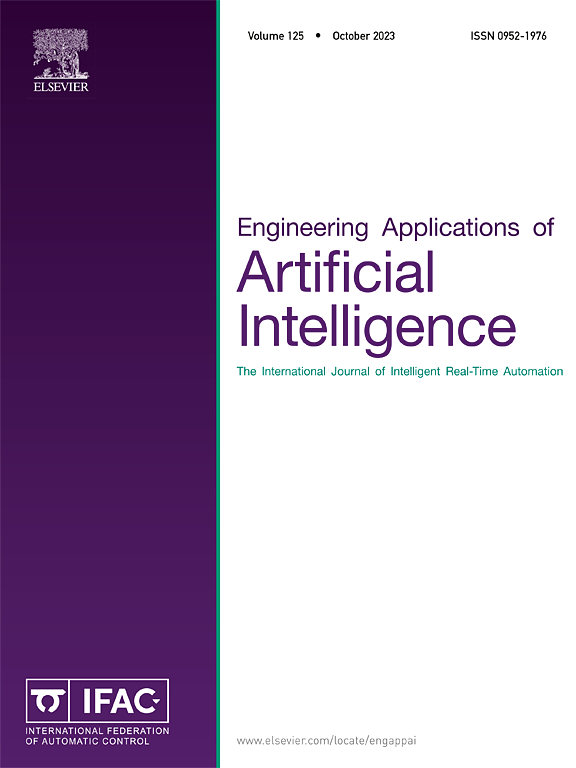A small object detection algorithm for mine environment
IF 7.5
2区 计算机科学
Q1 AUTOMATION & CONTROL SYSTEMS
Engineering Applications of Artificial Intelligence
Pub Date : 2025-05-02
DOI:10.1016/j.engappai.2025.110936
引用次数: 0
Abstract
The detection of protective equipment carried by underground mine operators is a crucial measure for preventing safety accidents and safeguarding personal life and property. However, current challenges include low object detection accuracy and difficulty detecting small objects, we propose a small object detection algorithm based on the improved You Only Look Once Version 8 (YOLOv8) for the mine environment. To minimize the semantic gap between features at different levels and enhance the feature fusion effect, the Asymptotic Feature Pyramid Network-Four (AFPN-F) has been designed to replace the Neck component of YOLOv8, enabling the detection model to better adapt to semantic information across varying levels. To enhance the model's sensitivity to small objects in the mine environment, a superficial feature output layer has been added to the model. This addition helps to prevent the loss of small-sized objects, which may contain limited feature information, during successive convolution operations. To address the significant differences in the scales of various objects in the mine, the More Focused Intersection over Union Loss (Focaler-IoU) is introduced as a loss function. This modification is intended to improve the handling of different types of regression samples, enhance training accuracy, and ensure that the model is more focused on small objects in the mine environment. The experimental results show that the proposed model outperforms other mainstream models. Compared to the baseline model YOLOv8, achieving an improvement of 3.7 percent in mean Average Precision (mAP), the number of parameters has been reduced by 30 percent, resulting in a model size of only 5 Megabytes. This study provides an effective solution for detecting small objects in underground mines.
一种针对矿山环境的小目标检测算法
对井下作业人员携带的防护装备进行检测,是防止安全事故发生、保障人身财产安全的重要措施。然而,目前存在目标检测精度低、小目标检测困难等问题,针对矿山环境,我们提出了一种基于改进的You Only Look Once Version 8 (YOLOv8)的小目标检测算法。为了最小化不同层次特征之间的语义差距,增强特征融合效果,设计了渐近特征金字塔网络-四(AFPN-F)来取代YOLOv8的Neck分量,使检测模型能够更好地适应不同层次的语义信息。为了提高模型对矿山环境中小物体的敏感性,在模型中增加了一个浅层特征输出层。这有助于防止在连续的卷积操作中丢失可能包含有限特征信息的小尺寸对象。为了解决矿井中各种目标尺度的显著差异,引入了多点聚焦交会(Focaler-IoU)作为损失函数。此修改旨在改进对不同类型回归样本的处理,提高训练精度,并确保模型更专注于矿山环境中的小物体。实验结果表明,该模型优于其他主流模型。与基线模型YOLOv8相比,平均平均精度(mAP)提高了3.7%,参数数量减少了30%,模型大小仅为5兆字节。该研究为地下矿山小目标的探测提供了有效的解决方案。
本文章由计算机程序翻译,如有差异,请以英文原文为准。
求助全文
约1分钟内获得全文
求助全文
来源期刊

Engineering Applications of Artificial Intelligence
工程技术-工程:电子与电气
CiteScore
9.60
自引率
10.00%
发文量
505
审稿时长
68 days
期刊介绍:
Artificial Intelligence (AI) is pivotal in driving the fourth industrial revolution, witnessing remarkable advancements across various machine learning methodologies. AI techniques have become indispensable tools for practicing engineers, enabling them to tackle previously insurmountable challenges. Engineering Applications of Artificial Intelligence serves as a global platform for the swift dissemination of research elucidating the practical application of AI methods across all engineering disciplines. Submitted papers are expected to present novel aspects of AI utilized in real-world engineering applications, validated using publicly available datasets to ensure the replicability of research outcomes. Join us in exploring the transformative potential of AI in engineering.
 求助内容:
求助内容: 应助结果提醒方式:
应助结果提醒方式:


